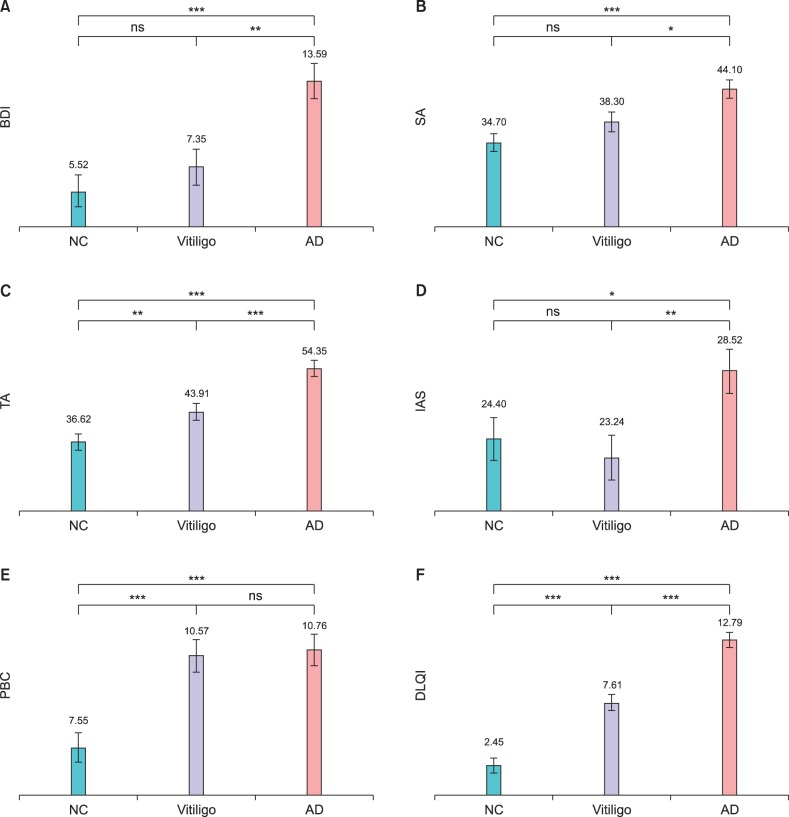Abstract
Background
Vitiligo and atopic dermatitis (AD) are common dermatological disorders which may cause significant psychological and social distress leading to impaired quality of life (QoL) in patients.
Objective
We evaluated the degree of psychological stress and impairment of QoL in vitiligo patients as compared with AD patients and normal controls (NCs).
Methods
A total of 60 patients from each group and 60 NCs were enrolled. Five questionnaires on depression (Beck depression inventory, BDI), state anxiety (SA) and trait anxiety (TA), interaction anxiousness (IAS), private body consciousness (PBC) and dermatologic QoL were used.
Results
The vitiligo patients had a significantly higher level of TA (p<0.01), PBC (p<0.001) and impaired QoL (p<0.001) than NCs, but not BDI, SA and IAS. The AD patients had significantly higher scores for all five questionnaire items compared with NCs. In the comparison between the AD and vitiligo groups, all of the indexes except body consciousness were higher in AD patients than in vitiligo patients: BDI (p<0.01), SA (p<0.05), TA (p<0.001), IAS (p<0.01) and impaired QoL (p<0.001). Exposure of vitiligo lesions was not a significant variable in the analysis of the contribution of clinical variables of vitiligo on psychological stress and QoL.
Conclusion
Vitiligo, which is not accompanied by any symptoms, involves less psychological impact than AD, which is accompanied by itching. Compared to NCs, however, the elevated general anxiety and body consciousness in patients with vitiligo suggests that they may be more concerned with the aggravation of hypopigmented patches than difficulties in social interactions.
Keywords: Atopic dermatitis, Psychological impacts, Vitiligo
INTRODUCTION
As skin is the largest and most visible part of the human body, patients with skin diseases often suffer from psychological stress and impaired quality of life (QoL) due to the appearance and subjective symptoms. Psychological aspects of skin diseases, including atopic dermatitis (AD), psoriasis, urticaria, alopecia areata and vitiligo, have been widely investigated. Understanding the psychological aspects of skin diseases and implementing psychological treatment approaches have been increasingly emphasized1-5.
Vitiligo is a depigmenting disorder that affects 0.5% to 1% of the total population. The etiology and pathogenesis of vitiligo are not well elucidated, but the loss and dysfunction of melanocytes are considered to play a major role in its pathogenesis. Vitiligo is characterized by hypopigmented macules of the skin or mucosa, with no accompanying subjective symptoms other than the skin lesion itself. Although vitiligo does not cause serious physical morbidity, patients with the disease may experience various degrees of psychological stress and altered QoL1,2.
The psychosocial impairments and altered QoL in vitiligo patients have been widely reported. It has been reported that patients with vitiligo experience emotional disturbances such as embarrassment, anger, worry or frustration6,7, and that the disease exerts a negative impact on social encounters including sexual relationship8 with an increased experience of stigmatization. Patients with vitiligo have also been reported to show impaired QoL9-11.
AD is a highly pruritic chronic relapsing skin disease. AD patients also experience impaired QoL and severe psychological stress; and moreover, the psychological stress can act as an aggravating factor in AD. Thus, psychological stress and AD symptoms such as pruritus and sleep loss have a cyclic effect on each other12. In particular, we have reported in a previous study that, among the various kinds of psychological parameters, anxiety was strongly associated with the symptoms of AD13.
In this study, we hypothesized that the degree of impairment of psychological parameters might be different between AD and vitiligo, with AD involving subjective symptoms such as pruritus along with skin lesions, unlike vitiligo. Previous reports have compared the psychological distress in patients with psoriasis and vitiligo11,14-16. In these studies, patients with psoriasis were generally reported to have a higher level of psychological distress than vitiligo patients, except that QoL impairment in female patients with vitiligo equalled the impairment caused by psoriasis11,15,16. However, to the best of our knowledge, no study has compared the psychological distress of patients with vitiligo and those with AD.
Thus in this study, we aimed to compare aspects of the psychological stress in vitiligo patients with those of normal controls (NCs) and AD patients, using questionnaires that assessed items associated with psychological stress and QoL.
MATERIALS AND METHODS
Subjects
This study was carried out in Severance Hospital, Yonsei University College of Medicine (Seoul, Korea) from March 2009 to February 2010. A total of 60 vitiligo patients and 60 AD patients were enrolled in this study. The diagnosis of vitiligo was made based on clinical manifestations and Wood's light examination. The diagnosis of AD was based on the criteria of Hanifin and Rajka17. Patients taking oral corticosteroids or psychotropic drugs, which can affect psychological status, were excluded from this study. None of the subjects had any other concomitant dermatological or psychological disorder. A total of 60 NCs, who did not have any dermatological, medical or psychological problems, were enrolled as a reference group. This study was approved by the institutional review board of Yonsei University (No 4-2008-0337) and informed consent was obtained from each patient (or from the parents of paediatric patients), before they participated in the study.
Information on demographic variables (age and gender) and disease-related characteristics (duration of the disease, localisation of vitiligo, family history of vitiligo, duration of treatment and treatment response) were collected from the patients with vitiligo. Information on demographic variables (age, gender) of patients with AD was also collected. The clinical severity of AD was graded according to the Eczema Area and Severity Index (EASI).
This study was approved by the Institutional Review Board of Yonsei University Health System, Severance Hospital (4-2013-0640).
Questionnaires regarding psychological parameters and quality of life
The questionnaire consisted of five tests, four of which evaluated psychological parameters of depression, anxiety, interaction anxiousness and private body consciousness (PBC), and one that assessed QoL13,18.
The Beck depression inventory second edition (BDI-II), a 21-question self-report inventory, was used to evaluate the existence and severity of symptoms of depression. The total value indicated the level and severity of depression. BDI-II has been assessed and validated in various medical populations19,20, and the Korean version of the BDI was previously shown to exhibit good psychometric properties21.
The Spielberger State-Trait Anxiety Inventory (STAI) is a self-report assessment device that measures the state and trait anxiety (TA). State anxiety (SA) refers to transitory anxiety under certain conditions and at certain times, which may be influenced by external factors. TA refers to the individual's anxiety in general and one's tendency in responding to anxiety. The Korean version of STAI has demonstrated excellent psychometric properties22.
Interaction Anxiousness Scale (IAS) was constructed to determine the tendency to feel nervous in specific situations. It consists of 15 items of anxiety-evoking situations, such as interactions with strangers, authority figures and members of the opposite gender. IAS is empirically derived and has been shown to have good test reliability, construct and criterion validity23.
PBC subscale is one of three subscales in the body consciousness questionnaires24. It consists of five items focusing on the symptoms of individuals such as attention to dry mouth, hunger and body temperature. Acceptable psychometric properties have been demonstrated24.
The Dermatology Life Quality Index (DLQI) questionnaire of Finlay and Khan25 was used to evaluate QoL of the enrolled subjects. DLQI is composed of a 10-question, self-report questionnaire, and is one of the most widely used dermatology-specific QoL instruments. Since its development in 1994, it has been used in many different skin diseases, and its validity and reliability have been demonstrated26. DLQI is calculated by adding the score of each question. The higher the score, the more the QoL is impaired.
Statistical analysis
All statistical tests were carried out using PASW Statistics software for Windows 18.0 (IBM Co., Armonk, NY, USA). We used ANOVA and chi-square test to compare age and sex of each group, respectively. A multiple linear regression analysis was performed to evaluate the contribution of clinical variables to the psychological and QoL indexes. Analysis of covariance (ANCOVA) and a multiple linear regression analysis were used to compare the values of psychological and QoL indexes among vitiligo patients, AD patients and NCs, introducing age and gender as covariates for adjustment. p<0.05 were considered statistically significant.
RESULTS
Demographic and clinical characteristics of study groups
In the NC group (Table 1), the mean age was 31.9±11.9 (18 to 59) years, and the ratio of male to female was 1.0:1.4. There were no significant differences in age and sex among the three groups.
Table 1.
Demographic characteristics of the study population

Values are presented as mean±standard deviation or number (%).
AD: atopic dermatitis, NC: normal control.
In the vitiligo group (Table 2), the mean age was 35.1±9.8 years (17 to 50 years), and the mean duration of disease was 6.76±7.05 years (1 to 34 years). The ratio of males to females was 1.00:0.93. Vitiligo lesions were present on exposed areas (head, face, neck and hands) in 83.6% of the patients and on non-exposed areas (arms, legs, feet, trunk, and genitals) in 16.4%. The most common type of vitiligo was vulgaris type (61.8%), followed by focal (23.6%), segmental (7.3%) and acrofacial (7.3%) types.
Table 2.
Demographic and clinical characteristics of patients with vitiligo
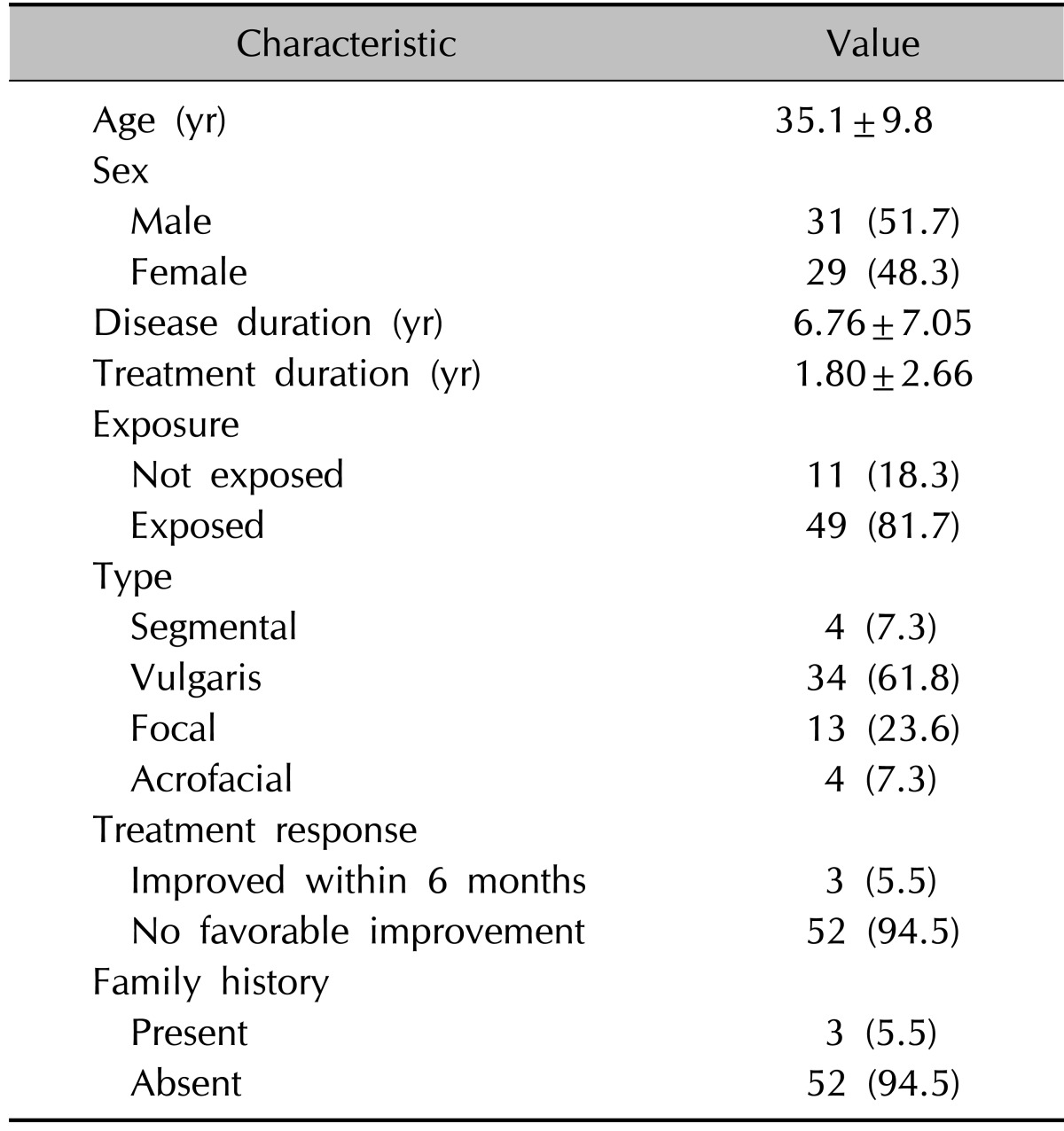
Values are presented as mean±standard deviation or number (%).
AD patients (Table 3) had a male to female ratio of 1.00 : 1.22, and a mean age of 32.4±7.9 years (21.0 to 55.0 years). The mean EASI score was 19.1±14.3 (2.7 to 59.1). Patients with AD were divided into three subgroups based on the EASI score: mild, less than 10 (34.1%); moderate, 10 to 20 (35.4%); and severe, greater than 20 (30.5%)27. The mean total serum immunoglobulin E level was 2,073.6±1,836.7 (kU/L).
Table 3.
Demographic and clinical characteristics of patients with atopic dermatitis
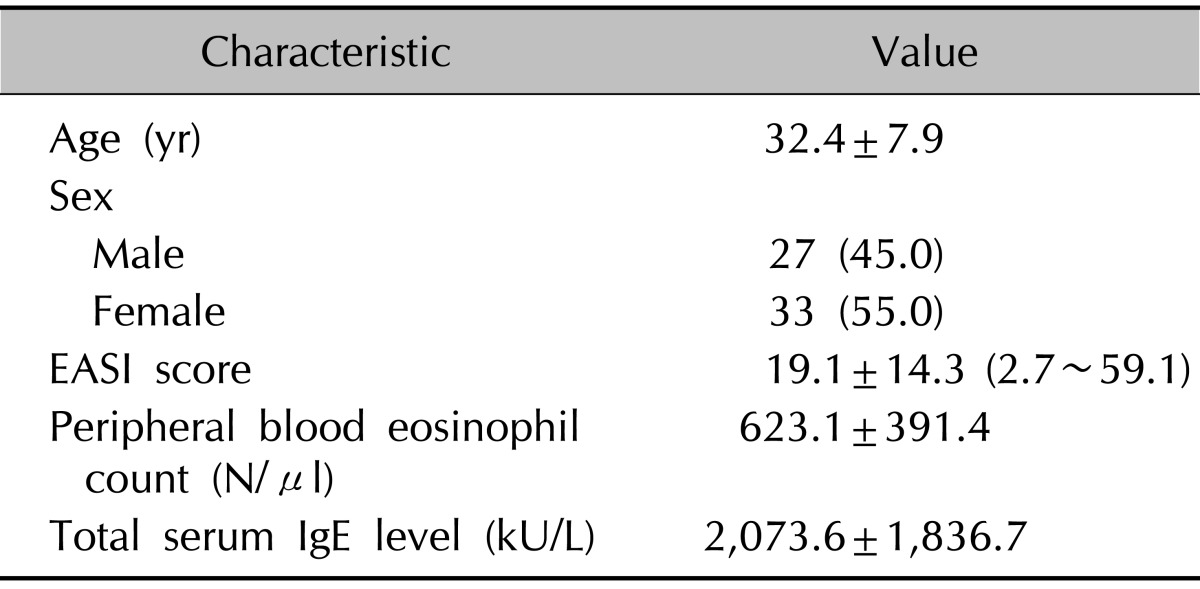
Values are presented as mean±standard deviation, number (%), or mean±standard deviation (range). EASI: Eczema Area and Severity Index, IgE: immunoglobulin E.
Effect of clinical variables on psychological parameters in the vitiligo group
In a multiple linear regression analysis with the psychological parameters as outcome variables and demographic and clinical variables as independent variables (Table 4), psychological parameters including depression, anxiety and body consciousness and DLQI did not show any correlations with age, sex or clinical patterns of vitiligo. However, vitiligo patients of younger age (β=-0.297, p<0.05) and with a longer duration of vitiligo (β=0.383, p<0.05) showed high scores for IAS. Patients with exposed lesions or involvement of the face and neck did not exhibit increased impairment of psychological aspects or QoL.
Table 4.
Multivariate analysis of factors associated with the interaction anxiousness scale (multiple linear regression analysis)
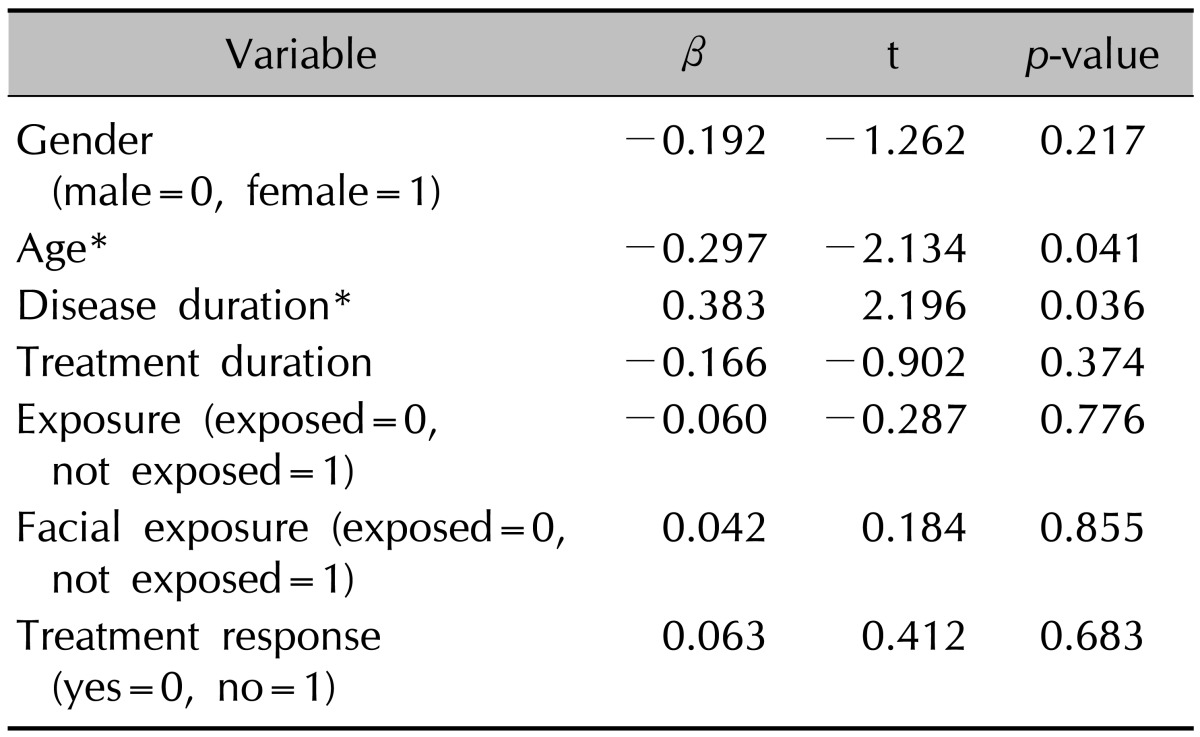
R2=0.45. *p<0.05.
Comparison of psychological parameters and quality of life among the three groups
In multivariate regression analysis, age and gender affected several psychological indexes and DLQI (Table 5). BDI (β=0.240, p<0.01), TA (β=0.148, p<0.05) and DLQI (β=0.128, p<0.05) showed higher values with increased age, while IAS showed lower values with age (β=-0.228, p<0.01). In addition, females exhibited elevated SA (β=0.164, p<0.05), TA (β=0.172, p<0.05) and PBC (β=0.167, p<0.05), more so than males. In ANCOVA analysis, vitiligo patients showed increased psychological morbidity for TA (p<0.01), PBC (p<0.001) and DLQI (p<0.001), compared with NCs (Fig. 1). In contrast, vitiligo patients did not show significantly elevated scores for BDI (p=0.309) and IAS (p=0.489), compared to NCs. All of the psychological parameters as well as DLQI were significantly higher in AD patients than in NCs. Moreover, in comparison to the vitiligo group, the AD group reported significantly higher scores for BDI (p<0.01), SA (p<0.05), TA (p<0.001), IAS (p<0.01) and DLQI (p<0.001), although there was no significant difference in PBC (p=0.797), which reflects internal physical sensation and hypochondriatic features.
Table 5.
Factors affecting psychological parameters in comparison with normal controls
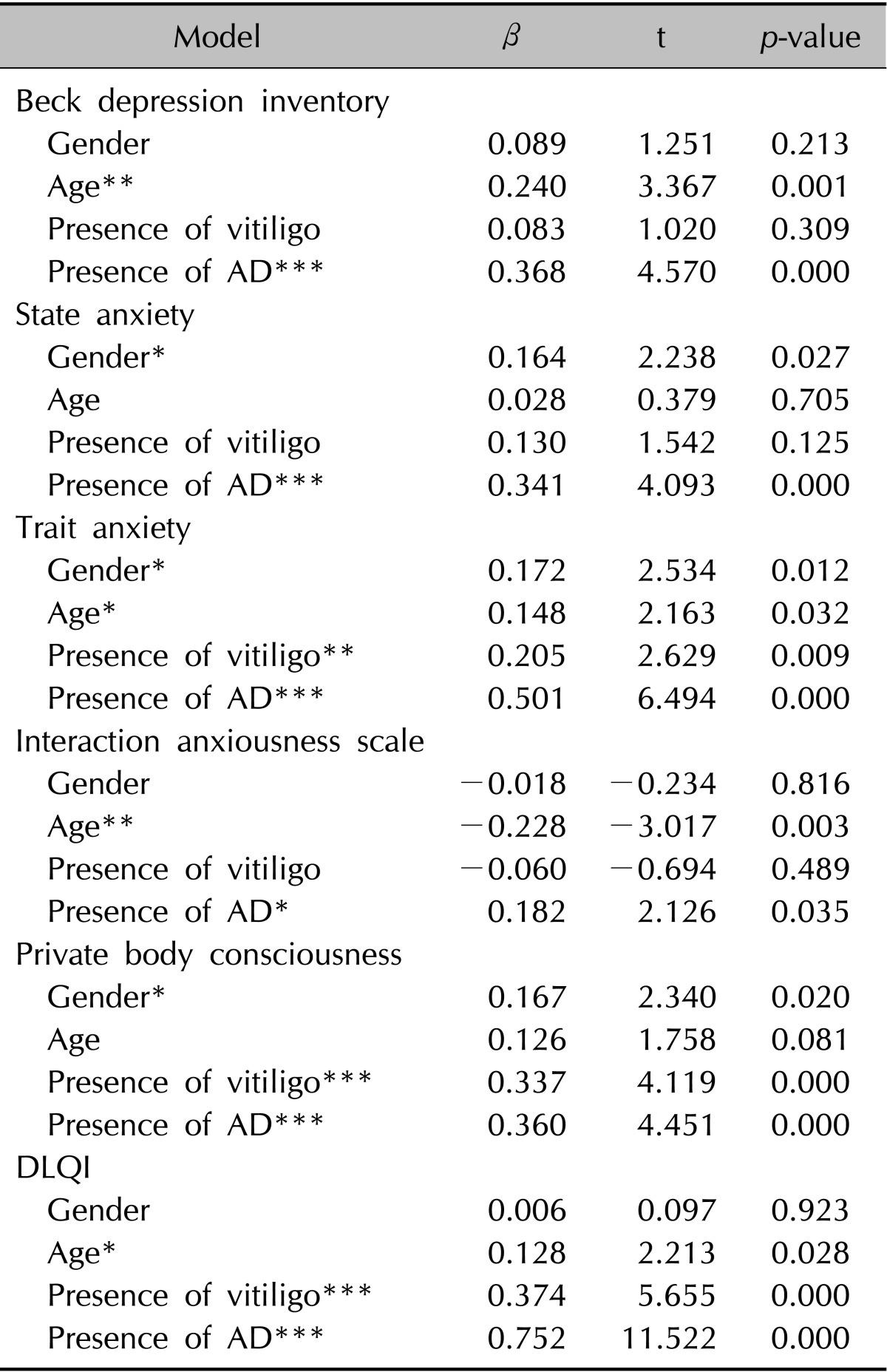
Gender: 0 if male, 1 if female. AD: atopic dermatitis, DLQI: Dermatology Life Quality Index. *p<0.05, **p<0.01, ***p<0.001.
Fig. 1.
Comparison of psychological indexes between normal controls (NCs), vitiligo and atopic dermatitis (AD) groups. Beck depression inventory (BDI) (A), state anxiety (SA) (B), trait anxiety (TA) (C), interaction anxiousness scale (IAS) (D), private body consciousness (PBC) (E) and Dermatology Life Quality Index (DLQI) (F). All parameters were significantly higher in the atopic dermatitis group than in the normal controls. The vitiligo group showed significantly higher TA, PBC and DLQI than the normal controls. IAS was elevated in the normal controls compared with the vitiligo group, but was not statistically significant. ns: not significant. *p<0.05; **p<0.01; ***p<0.001.
DISCUSSION
Vitiligo, characterized by hypopigmented lesions on the skin, can cause psychological stress such as depression, anxiety and problematic social relations, which can lead to significantly impaired QoL. The psychological aspects can also modify the course of the illness; for example, depression and anxiety can lead to treatment noncompliance and a consequent worsening of vitiligo28. In this regard, the psychological effects of vitiligo have been copiously described in the literature.
There have been many reports suggesting the negative psychological effects of vitiligo. Most of the previous studies regarding vitiligo focused on one or two aspects among the multiple psychosocial problems, including depression, anxiety, low self-esteem, negative experiences in sexual relationships and impaired QoL2,6-9,29-32. Although there are reports comparing the psychological impacts of vitiligo and psoriasis, the psychological aspects of skin diseases with and without subjective symptoms have rarely been studied, and the psychological aspects of vitiligo and AD have been compared in only a few studies. In the present study, we compared psychological stress in patients with vitiligo, AD patients and NCs using questionnaires that evaluated various psychological aspects including depression, anxiety, interaction anxiousness, body consciousness and QoL. We attempted to investigate whether psychological aspects of skin diseases are affected by other accompanying subjective symptoms besides the external appearance of the skin lesions.
Sampogna et al.7 reported that the prevalence of depression in vitiligo patients was higher than that of the general Western white population. From our study, depression did not appear to be significantly higher in vitiligo patients than in NCs. Regarding the prevalence of anxiety in vitiligo, various studies have yielded conflicting results. Some reports suggested that anxiety was more prevalent in vitiligo patients as compared with the general population6,7, while Bilgiç et al.29 reported that children and adolescents with vitiligo did not show increased levels of anxiety compared with controls. In our study, we used STAI to evaluate both the situational and general anxiety. Patients with vitiligo showed a significantly elevated TA, but not SA, than NCs, signifying that vitiligo patients experienced a higher level of general anxiety, but not situational anxiety. Also, body consciousness was shown to be elevated in patients with vitiligo compared to NCs, indicating that vitiligo patients were more greatly concerned with the physical appearance and representation.
It might be expected that visible skin lesions would have a negative impact on social interactions and QoL, as shown in patients (especially women) with visible skin lesions, who have been shown to exhibit increased psychiatric morbidity33. In the present study, however, social interaction anxiousness as measured by IAS, which related to anxiety experienced in social relations and meetings, was not influenced by the presence of vitiligo or exposed vitiligo lesions, such as on the face and neck. Different studies on the impact of the visibility of vitiligo lesions on psychosocial difficulties have produced inconsistent results7,10,16,31,34,35. The restoration of impaired QoL after using cosmetic camouflage implied that the visibility of vitiligo lesions had a negative impact on the patients' lives10,34. On the contrary, opposing reports have suggested that lesion visibility does not affect psychological aspects in patients with vitiligo7,31,35. Schmid-Ott et al.35 reported that the location of vitiligo does not play a critical role in the overall stigma and that the presence of vitiligo on the face or the hands has been reported to show no association with the impaired QoL31. Another study reported no negative impact of facial lesions on QoL, especially in women, presumably because female patients with vitiligo can hide facial lesions with cosmetics7. Overall, it remains controversial as to whether the visibility of skin lesions is critical to psychological morbidity in patients with vitiligo.
DLQI is widely used for assessment of QoL in various skin diseases. DLQI scores in vitiligo patients have ranged 3.18 to 10.67 in different studies10,34,36-38. In this study, the mean score of DLQI in vitiligo patients was 7.61, and the vitiligo group demonstrated a significantly impaired QoL compared with the NC group. As the QoL of patients with vitiligo has been reported to be more closely related to the patients' subjective assessment of the disease rather than the clinical severity of the condition30, an elevated general anxiety and body consciousness in vitiligo patients may have contributed to the elevated levels in DLQI, compared to NCs.
In the analysis of the effects of demographic and clinical manifestations on the psychological parameters, all enrolled participants of older age showed a lower level of interaction anxiousness. This result indicated that older patients coped better in the social interactions. However, older patients tended to show higher levels of depression, anxiety (state and trait) and lower QoL. State and TA, as well as body consciousness, were higher among females than among males. This finding is consistent with previous psychological literature which showed that women exhibit a higher level of anxiety and concerns with physical appearance39-41. In the analysis of the vitiligo group, vitiligo patients with a longer disease duration reported higher values for IAS. While older age is generally associated with longer disease duration, the correlation between age and disease duration was not observed in this study group, which implies that age and disease duration affect IAS independently.
Consistent with previous findings on psychological distress in patients with AD18,42,43, all psychological parameters were significantly higher in the AD group than in the NC group in our study. Furthermore, when compared with vitiligo, all psychological parameters except for PBC were significantly higher in the AD group than in the vitiligo group. As a large number of patients with moderate and severe AD are included in this study, the severity of AD may have elevated psychological stress and worsened QoL compared with the vitiligo group. Pruritus, a main symptom of AD, is known to be related with anxiety through neuropeptide Y and nerve growth factor18, and may play a critical role in causing psychological stress. Considering that vitiligo is not usually accompanied by any subjective symptoms such as itching, it may be hypothesized that the presence of symptoms such as pruritus in AD may have elevated the psychological stress and impaired QoL.
In the case of PBC subscales, which assess attention to internal physical sensations and hypochondriatic features, the vitiligo patients showed no significant difference from AD patients, despite significantly higher values of PBC compared with the NC group. Taken together with the results for IAS, which was not elevated in vitiligo patients, we suggest that vitiligo patients might be more concerned with the spreading or aggravation of the hypopigmented lesions on their bodies than the social problems associated with unwanted attention from other people. In this context, we may assume that non-exposed skin lesions can also distress vitiligo patients.
Cross-sectional in nature, this study is limited in that it is reflective of the psychological aspects at any given point, which may fluctuate in time. Repeated longitudinal studies may overcome this limitation. Also, by including additional factors such as the degree of pruritus and loss of sleep in patients with AD, the role of such symptoms in elevating psychological stress may be clarified in a further study. The comparison of four different psychological aspects as well as QoL in patients with vitiligo and AD is a unique and distinguishing feature of this study.
In conclusion, the degree of psychological stress and impaired QoL may be different in patients with different skin diseases depending on the presence of skin symptoms. While the patients with vitiligo in this study showed less psychological stress and less impaired QoL than AD patients, they still exhibited elevated levels of anxiety and body consciousness, as well as more impaired QoL in comparison to NCs. Also, physicians should be aware that even unexposed vitiligo lesions may distress patients, and that patients with vitiligo may be more concerned with the aggravation of hypopigmented patches on the body, even those unexposed, than with difficulties in social interactions.
References
- 1.Kim do Y, Lee JW, Whang SH, Park YK, Hann SK, Shin YJ. Quality of life for Korean patients with vitiligo: Skindex-29 and its correlation with clinical profiles. J Dermatol. 2009;36:317–322. doi: 10.1111/j.1346-8138.2009.00646.x. [DOI] [PubMed] [Google Scholar]
- 2.Parsad D, Dogra S, Kanwar AJ. Quality of life in patients with vitiligo. Health Qual Life Outcomes. 2003;1:58. doi: 10.1186/1477-7525-1-58. [DOI] [PMC free article] [PubMed] [Google Scholar]
- 3.Grob JJ, Revuz J, Ortonne JP, Auquier P, Lorette G. Comparative study of the impact of chronic urticaria, psoriasis and atopic dermatitis on the quality of life. Br J Dermatol. 2005;152:289–295. doi: 10.1111/j.1365-2133.2005.06385.x. [DOI] [PubMed] [Google Scholar]
- 4.Misery L, Finlay AY, Martin N, Boussetta S, Nguyen C, Myon E, et al. Atopic dermatitis: impact on the quality of life of patients and their partners. Dermatology. 2007;215:123–129. doi: 10.1159/000104263. [DOI] [PubMed] [Google Scholar]
- 5.Chu SY, Chen YJ, Tseng WC, Lin MW, Chen TJ, Hwang CY, et al. Psychiatric comorbidities in patients with alopecia areata in Taiwan: a case-control study. Br J Dermatol. 2012;166:525–531. doi: 10.1111/j.1365-2133.2011.10714.x. [DOI] [PubMed] [Google Scholar]
- 6.Kent G, Al'Abadie M. Psychologic effects of vitiligo: a critical incident analysis. J Am Acad Dermatol. 1996;35:895–898. doi: 10.1016/s0190-9622(96)90112-7. [DOI] [PubMed] [Google Scholar]
- 7.Sampogna F, Raskovic D, Guerra L, Pedicelli C, Tabolli S, Leoni L, et al. Identification of categories at risk for high quality of life impairment in patients with vitiligo. Br J Dermatol. 2008;159:351–359. doi: 10.1111/j.1365-2133.2008.08678.x. [DOI] [PubMed] [Google Scholar]
- 8.Porter JR, Beuf AH, Lerner AB, Nordlund JJ. The effect of vitiligo on sexual relationships. J Am Acad Dermatol. 1990;22:221–222. doi: 10.1016/0190-9622(90)70028-g. [DOI] [PubMed] [Google Scholar]
- 9.Belhadjali H, Amri M, Mecheri A, Doarika A, Khorchani H, Youssef M, et al. Vitiligo and quality of life: a case-control study. Ann Dermatol Venereol. 2007;134:233–236. doi: 10.1016/s0151-9638(07)91814-1. [DOI] [PubMed] [Google Scholar]
- 10.Ongenae K, Dierckxsens L, Brochez L, van Geel N, Naeyaert JM. Quality of life and stigmatization profile in a cohort of vitiligo patients and effect of the use of camouflage. Dermatology. 2005;210:279–285. doi: 10.1159/000084751. [DOI] [PubMed] [Google Scholar]
- 11.Sharma N, Koranne RV, Singh RK. Psychiatric morbidity in psoriasis and vitiligo: a comparative study. J Dermatol. 2001;28:419–423. doi: 10.1111/j.1346-8138.2001.tb00003.x. [DOI] [PubMed] [Google Scholar]
- 12.Hashizume H, Takigawa M. Anxiety in allergy and atopic dermatitis. Curr Opin Allergy Clin Immunol. 2006;6:335–339. doi: 10.1097/01.all.0000244793.03239.40. [DOI] [PubMed] [Google Scholar]
- 13.Bae BG, Oh SH, Park CO, Noh S, Noh JY, Kim KR, et al. Progressive muscle relaxation therapy for atopic dermatitis: objective assessment of efficacy. Acta Derm Venereol. 2012;92:57–61. doi: 10.2340/00015555-1189. [DOI] [PubMed] [Google Scholar]
- 14.Mattoo SK, Handa S, Kaur I, Gupta N, Malhotra R. Psychiatric morbidity in vitiligo and psoriasis: a comparative study from India. J Dermatol. 2001;28:424–432. doi: 10.1111/j.1346-8138.2001.tb00004.x. [DOI] [PubMed] [Google Scholar]
- 15.Porter JR, Beuf AH, Lerner A, Nordlund J. Psychosocial effect of vitiligo: a comparison of vitiligo patients with "normal" control subjects, with psoriasis patients, and with patients with other pigmentary disorders. J Am Acad Dermatol. 1986;15:220–224. doi: 10.1016/s0190-9622(86)70160-6. [DOI] [PubMed] [Google Scholar]
- 16.Ongenae K, Van Geel N, De Schepper S, Naeyaert JM. Effect of vitiligo on self-reported health-related quality of life. Br J Dermatol. 2005;152:1165–1172. doi: 10.1111/j.1365-2133.2005.06456.x. [DOI] [PubMed] [Google Scholar]
- 17.Hanifin JM, Rajka G. Diagnostic features of atopic dermatitis. Acta Derm Venereol. 1980;s92:44–47. [Google Scholar]
- 18.Oh SH, Bae BG, Park CO, Noh JY, Park IH, Wu WH, et al. Association of stress with symptoms of atopic dermatitis. Acta Derm Venereol. 2010;90:582–588. doi: 10.2340/00015555-0933. [DOI] [PubMed] [Google Scholar]
- 19.Carney CE, Ulmer C, Edinger JD, Krystal AD, Knauss F. Assessing depression symptoms in those with insomnia: an examination of the beck depression inventory second edition (BDI-II) J Psychiatr Res. 2009;43:576–582. doi: 10.1016/j.jpsychires.2008.09.002. [DOI] [PMC free article] [PubMed] [Google Scholar]
- 20.Poole H, Bramwell R, Murphy P. Factor structure of the beck depression inventory-II in patients with chronic pain. Clin J Pain. 2006;22:790–798. doi: 10.1097/01.ajp.0000210930.20322.93. [DOI] [PubMed] [Google Scholar]
- 21.Hahn HM, Yum TH, Shin YW, Kim KH, Yoon DJ, Chung KJ. A standardization study of the Beck Depression Inventory in Korea. J Korean Neuropsychiatr Assoc. 1986;25:487–502. [Google Scholar]
- 22.Hahn DW, Lee CH, Chon KK. Korean adaptation of Spielberger's STAI (K-STAI) Korean J Health Psychol. 1996;1:1–14. [Google Scholar]
- 23.Leary MR. Social anxiousness: the construct and its measurement. J Pers Assess. 1983;47:66–75. doi: 10.1207/s15327752jpa4701_8. [DOI] [PubMed] [Google Scholar]
- 24.Miller LC, Murphy R, Buss AH. Consciousness of body: Private and public. J Pers Soc Psychol. 1981;41:397–406. [Google Scholar]
- 25.Finlay AY, Khan GK. Dermatology Life Quality Index (DLQI)-a simple practical measure for routine clinical use. Clin Exp Dermatol. 1994;19:210–216. doi: 10.1111/j.1365-2230.1994.tb01167.x. [DOI] [PubMed] [Google Scholar]
- 26.Basra MK, Fenech R, Gatt RM, Salek MS, Finlay AY. The Dermatology Life Quality Index 1994-2007: a comprehensive review of validation data and clinical results. Br J Dermatol. 2008;159:997–1035. doi: 10.1111/j.1365-2133.2008.08832.x. [DOI] [PubMed] [Google Scholar]
- 27.Wu WH, Park CO, Oh SH, Kim HJ, Kwon YS, Bae BG, et al. Thymic stromal lymphopoietin-activated invariant natural killer T cells trigger an innate allergic immune response in atopic dermatitis. J Allergy Clin Immunol. 2010;126:290–299. doi: 10.1016/j.jaci.2010.05.024. [DOI] [PubMed] [Google Scholar]
- 28.DiMatteo MR, Lepper HS, Croghan TW. Depression is a risk factor for noncompliance with medical treatment: meta-analysis of the effects of anxiety and depression on patient adherence. Arch Intern Med. 2000;160:2101–2107. doi: 10.1001/archinte.160.14.2101. [DOI] [PubMed] [Google Scholar]
- 29.Bilgiç O, Bilgiç A, Akiş HK, Eskioğu F, Kiliç EZ. Depression, anxiety and health-related quality of life in children and adolescents with vitiligo. Clin Exp Dermatol. 2011;36:360–365. doi: 10.1111/j.1365-2230.2010.03965.x. [DOI] [PubMed] [Google Scholar]
- 30.Choi S, Kim DY, Whang SH, Lee JH, Hann SK, Shin YJ. Quality of life and psychological adaptation of Korean adolescents with vitiligo. J Eur Acad Dermatol Venereol. 2010;24:524–529. doi: 10.1111/j.1468-3083.2009.03452.x. [DOI] [PubMed] [Google Scholar]
- 31.Linthorst Homan MW, Spuls PI, de Korte J, Bos JD, Sprangers MA, van der Veen JP. The burden of vitiligo: patient characteristics associated with quality of life. J Am Acad Dermatol. 2009;61:411–420. doi: 10.1016/j.jaad.2009.03.022. [DOI] [PubMed] [Google Scholar]
- 32.Kent G, al-Abadie M. Factors affecting responses on Dermatology Life Quality Index items among vitiligo sufferers. Clin Exp Dermatol. 1996;21:330–333. [PubMed] [Google Scholar]
- 33.Picardi A, Abeni D, Renzi C, Braga M, Puddu P, Pasquini P. Increased psychiatric morbidity in female outpatients with skin lesions on visible parts of the body. Acta Derm Venereol. 2001;81:410–414. doi: 10.1080/000155501317208345. [DOI] [PubMed] [Google Scholar]
- 34.Tanioka M, Yamamoto Y, Kato M, Miyachi Y. Camouflage for patients with vitiligo vulgaris improved their quality of life. J Cosmet Dermatol. 2010;9:72–75. doi: 10.1111/j.1473-2165.2010.00479.x. [DOI] [PubMed] [Google Scholar]
- 35.Schmid-Ott G, Künsebeck HW, Jecht E, Shimshoni R, Lazaroff I, Schallmayer S, et al. Stigmatization experience, coping and sense of coherence in vitiligo patients. J Eur Acad Dermatol Venereol. 2007;21:456–461. doi: 10.1111/j.1468-3083.2006.01897.x. [DOI] [PubMed] [Google Scholar]
- 36.Parsad D, Pandhi R, Dogra S, Kanwar AJ, Kumar B. Dermatology Life Quality Index score in vitiligo and its impact on the treatment outcome. Br J Dermatol. 2003;148:373–374. doi: 10.1046/j.1365-2133.2003.05097_9.x. [DOI] [PubMed] [Google Scholar]
- 37.Wang KY, Wang KH, Zhang ZP. Health-related quality of life and marital quality of vitiligo patients in China. J Eur Acad Dermatol Venereol. 2011;25:429–435. doi: 10.1111/j.1468-3083.2010.03808.x. [DOI] [PubMed] [Google Scholar]
- 38.Kostopoulou P, Jouary T, Quintard B, Ezzedine K, Marques S, Boutchnei S, et al. Objective vs. subjective factors in the psychological impact of vitiligo: the experience from a French referral centre. Br J Dermatol. 2009;161:128–133. doi: 10.1111/j.1365-2133.2009.09077.x. [DOI] [PubMed] [Google Scholar]
- 39.Stewart SH, Taylor S, Baker JM. Gender differences in dimensions of anxiety sensitivity. J Anxiety Disord. 1997;11:179–200. doi: 10.1016/s0887-6185(97)00005-4. [DOI] [PubMed] [Google Scholar]
- 40.McCleary R, Zucker EL. Higher trait- and state-anxiety in female law students than male law students. Psychol Rep. 1991;68:1075–1078. doi: 10.2466/pr0.1991.68.3c.1075. [DOI] [PubMed] [Google Scholar]
- 41.Nakazato K, Shimonaka Y. The Japanese State-Trait Anxiety Inventory: age and sex differences. Percept Mot Skills. 1989;69:611–617. doi: 10.2466/pms.1989.69.2.611. [DOI] [PubMed] [Google Scholar]
- 42.Hashiro M, Okumura M. Anxiety, depression and psychosomatic symptoms in patients with atopic dermatitis: comparison with normal controls and among groups of different degrees of severity. J Dermatol Sci. 1997;14:63–67. doi: 10.1016/s0923-1811(96)00553-1. [DOI] [PubMed] [Google Scholar]
- 43.Arima M, Shimizu Y, Sowa J, Narita T, Nishi I, Iwata N, et al. Psychosomatic analysis of atopic dermatitis using a psychological test. J Dermatol. 2005;32:160–168. doi: 10.1111/j.1346-8138.2005.tb00738.x. [DOI] [PubMed] [Google Scholar]



